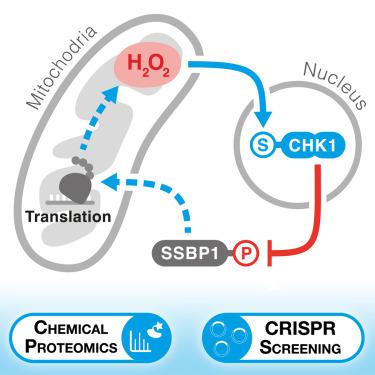Cell ( IF 45.5 ) Pub Date : 2023-05-15 , DOI: 10.1016/j.cell.2023.04.026 Junbing Zhang 1 , Claire M Simpson 2 , Jacqueline Berner 1 , Harrison B Chong 1 , Jiafeng Fang 1 , Zehra Ordulu 3 , Tommy Weiss-Sadan 1 , Anthony P Possemato 2 , Stefan Harry 1 , Mariko Takahashi 1 , Tzu-Yi Yang 1 , Marianne Richter 1 , Himani Patel 1 , Abby E Smith 1 , Alexander D Carlin 1 , Adriaan F Hubertus de Groot 1 , Konstantin Wolf 1 , Lei Shi 1 , Ting-Yu Wei 1 , Benedikt R Dürr 1 , Nicholas J Chen 1 , Tristan Vornbäumen 1 , Nina O Wichmann 1 , Mohammed S Mahamdeh 4 , Venkatesh Pooladanda 5 , Yusuke Matoba 5 , Shaan Kumar 6 , Eugene Kim 6 , Sara Bouberhan 7 , Esther Oliva 8 , Bo R Rueda 5 , Roy J Soberman 9 , Nabeel Bardeesy 10 , Brian B Liau 11 , Michael Lawrence 10 , Matt P Stokes 2 , Sean A Beausoleil 2 , Liron Bar-Peled 10

|
Multiple anticancer drugs have been proposed to cause cell death, in part, by increasing the steady-state levels of cellular reactive oxygen species (ROS). However, for most of these drugs, exactly how the resultant ROS function and are sensed is poorly understood. It remains unclear which proteins the ROS modify and their roles in drug sensitivity/resistance. To answer these questions, we examined 11 anticancer drugs with an integrated proteogenomic approach identifying not only many unique targets but also shared ones—including ribosomal components, suggesting common mechanisms by which drugs regulate translation. We focus on CHK1 that we find is a nuclear H2O2 sensor that launches a cellular program to dampen ROS. CHK1 phosphorylates the mitochondrial DNA-binding protein SSBP1 to prevent its mitochondrial localization, which in turn decreases nuclear H2O2. Our results reveal a druggable nucleus-to-mitochondria ROS-sensing pathway—required to resolve nuclear H2O2 accumulation and mediate resistance to platinum-based agents in ovarian cancers.
中文翻译:

抗癌药物靶点的系统鉴定揭示了细胞核到线粒体的ROS传感途径
多种抗癌药物被认为可以部分通过增加细胞活性氧(ROS)的稳态水平来导致细胞死亡。然而,对于大多数此类药物,人们对所产生的 ROS 的具体功能和感知方式知之甚少。目前尚不清楚 ROS 修饰哪些蛋白质及其在药物敏感性/耐药性中的作用。为了回答这些问题,我们采用综合蛋白质组学方法检查了 11 种抗癌药物,不仅确定了许多独特的靶点,还确定了共享的靶点(包括核糖体成分),从而提出了药物调节翻译的常见机制。我们重点关注 CHK1,我们发现它是一种核 H 2 O 2传感器,可以启动细胞程序来抑制 ROS。 CHK1 磷酸化线粒体 DNA 结合蛋白 SSBP1 以阻止其线粒体定位,从而减少核 H 2 O 2 。我们的结果揭示了一种可药物化的细胞核到线粒体 ROS 传感通路,该通路是解决卵巢癌中 H 2 O 2核积累和介导铂类药物耐药性所必需的。











































 京公网安备 11010802027423号
京公网安备 11010802027423号